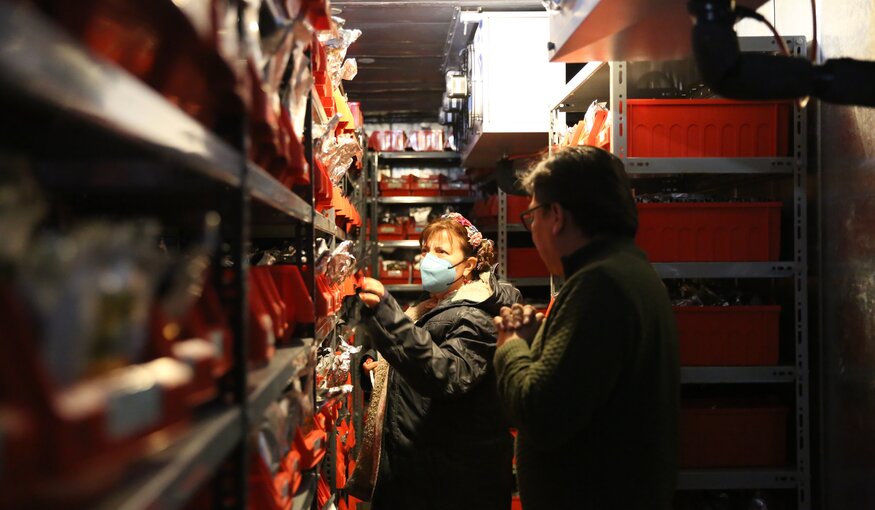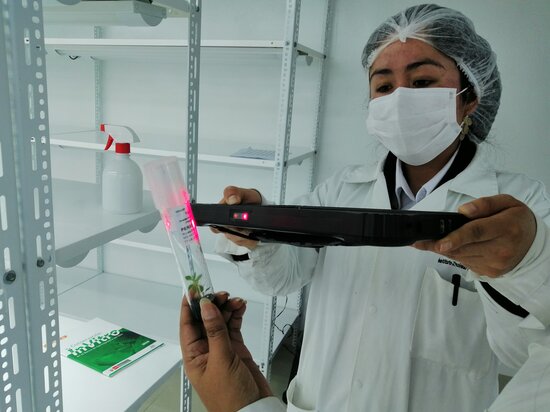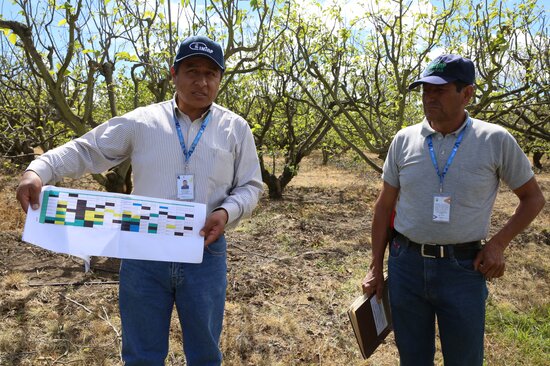Strengthening Genebanks in Ecuador and Peru
 Marise Borja, one of the BOLD genebank reviewers, examines the INIAP long-term storage cold room. She is accompanied by Alvaro Monteros, the Delegate Manager at the National Department of Plant Genetic Resources in Ecuador. Photo: Crop Trust/Luis Salazar
Marise Borja, one of the BOLD genebank reviewers, examines the INIAP long-term storage cold room. She is accompanied by Alvaro Monteros, the Delegate Manager at the National Department of Plant Genetic Resources in Ecuador. Photo: Crop Trust/Luis Salazar11 August 2022
A team of experts traveled to Ecuador and Peru to review the national genebanks in a visit organized by the Crop Trust under the Biodiversity for Opportunities, Livelihoods and Development (BOLD) Project.
Ecuador and Peru are part of the centers of diversity of a wide range of crops that underpin food security.
Quinoa, and Andean roots and tubers such as oca, the most widely grown tuber after potato, are essential for national and regional food security, while potato, tomato, beans and cassava play a key role globally.
These two countries are also host to many tropical fruit species, such as cherimoya and naranjilla, and also cacao, whose roasted beans are used to make chocolate.
Clonal Crops Present Challenges
“The genebanks in Ecuador and Peru are somewhat different to the other genebanks we have visited so far,” said Jean Hanson, a genetic resources specialist with more than 35 years of experience in the field and the leader of the BOLD review team visiting the two genebanks.
Unlike genebanks that primarily maintain seeds, those in Ecuador and Peru have to maintain a lot of their collections in the field or in vitro. This is because many of the crops they work with do not produce so-called orthodox seeds – that is, seeds that can be dried and stored at low temperatures.
This means that they face challenges that seed genebanks don’t. Plants in field genebanks are exposed to all kinds of pests and diseases throughout the growing season, so keeping them healthy is a major undertaking.
And duplicating the collections for safety is also an immense task. Field genebanks take up a lot of land, and require much more labor and management than collections of seeds in cold storage, so they are substantially more expensive to maintain.
Keeping samples in vitro or stored in liquid nitrogen – cryopreservation – is one way that the collections can be more easily duplicated, but both options are expensive and require specialized expertise and equipment.
“The Staff Are Totally Dedicated”
Despite these difficulties, what stood out for the review team was the dedication of the staff at both genebanks. Even in the face of challenges like short-staffing and budget constraints, their commitment to their work was total.
Genebank staff are highly skilled and work in specialist areas – and this can create a sense of isolation because they may not have a wide network of colleagues working in the same area in their home countries. This is where projects like BOLD, and the Crop Wild Relatives Project before it, can make a real difference.
“It is noticeable in the first couple of days of these reviews, genebank staff tend to feel intimidated by the review team and feel judged,” said Jean. “But as the week goes on, they come to see the value of this kind of interaction, the opportunity it offers for exchange of ideas with fellow professionals, and then the discussions really open up.”
This dedication to crop diversity conservation and use is being noticed.
The governments of both Ecuador and Peru are committing funds to their national genebanks. The Peruvian national genebank, for example, will expand and will build new facilities with funding from its government.
The situation in Ecuador is less clearcut. Despite government commitment to funding the sector, actual amounts received depend on annual budgets that vary from year to year. Assuring long-term conservation and availability thus continues to be difficult.
Tailoring Recommendations to Local Needs
Following the visit to the genebank, and discussions with the staff and management, the reviewers present a set of recommendations that address its key needs.
The review team, all experts in genebank management, can offer suggestions on how to approach these and where the project can offer targeted technical or financial support.
These suggestions often include minor changes that can lead to big improvements in how the genebank operates. For example, an easy way to reduce costs is by improving seed-drying facilities, because seeds last much longer if they have been properly dried.
"We appreciate the cordial and candid discussions we've had with the reviewers," said Alvaro Monteros Altamirano, the Delegate Manager at the National Department of Plant Genetic Resources in Ecuador. "Their recommendations, and the work we do with BOLD in the coming years, will without a doubt help us in our conservation efforts."
Urgent Changes
In Ecuador, a priority is to develop an up-to-date inventory of all the clonal crop diversity in the field genebanks. The genebank does not have a complete record of how much diversity there is in these collections, or how much duplication there is. Having this information will help the genebank to streamline work with clonal crops and could lead to major savings.
In Peru, the review team identified a number of urgent actions needed for the orthodox seed collection, including more viability testing and regenerating of seed stocks.
Knowing the current viability – or health – of the seed samples in the collection is essential to ensure that the genebank holds enough material to meet demand and storage requirements.
Another area that needs to be addressed is documenting the use made of the conserved diversity. Both of the genebanks are making their collections available to partners, including farmers, breeders and other researchers, but improved record-keeping is crucial.
Keeping track of where the diversity goes and what is done with it is an essential way for genebanks to document their value to the country, which will help them in securing funding from the government.
This is not unique to the genebanks in Ecuador and Peru – reviewers have seen this in most of the genebanks they have visited.
A Huge Effort
The BOLD Project has completed the reviews of six of the 15 genebanks it will be working with over the next several years, and the rest of the reviews will be completed by the end of 2022.
This is a huge undertaking, for both the reviewers and the genebank staff.
“We are very grateful to all of the reviewers, genebank staff and other stakeholders who have committed so much time and effort to these reviews,” said Nelissa Jamora, the Crop Trust staff member who is leading this aspect of the BOLD Project. “This work will provide the foundation of our relationships with these genebanks for the duration of the project.”
Category: BOLD





